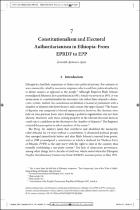| dc.contributor.author | Zemelak, Ayele | |
| dc.date.accessioned | 2022-12-05T10:38:14Z | |
| dc.date.available | 2022-12-05T10:38:14Z | |
| dc.date.issued | 2020 | |
| dc.identifier.citation | Ayele, Zemelak ‘Constitutionalism and electoral authoritarianism in Ethiopia: From EPRDF to EPP’ in Charles Fombad and Nico Steytler (eds.) Democracy, Elections, and Constitutionalism in Africa (Oxford University Press, 2021) pp. 169-197 | en_US |
| dc.identifier.issn | DOI: 10.1093/oso/9780192894779.003.0008 | |
| dc.identifier.uri | http://hdl.handle.net/10566/8186 | |
| dc.description.abstract | Ethiopia has had little experience of democratic political systems. For centuries it
was a monarchy, ruled by successive emperors who traced their political authority
to divine sources as opposed to the people.1 Although Emperor Haile Selassie
promulgated Ethiopia’s first constitution in 1931, which was revised in 1955, it was
meant more to constitutionalize his autocratic rule rather than entrench a democratic system. Indeed, the constitution established a bicameral parliament with a
chamber of deputies (the lower house) and a senate (the upper house).2 The house
of deputies was composed of elected representatives; however, the elections were
held on non-partisan basis, since forming a political organization was not then
allowed. Moreover, only those owning property in the relevant electoral districts
could run as candidates in the elections to the chamber of deputies.3 The Emperor
retained the prerogative to select members of the senate.4 | en_US |
| dc.language.iso | en | en_US |
| dc.publisher | Oxford University | en_US |
| dc.subject | Democratic political systems | en_US |
| dc.subject | Ethiopia | en_US |
| dc.subject | Constitution | en_US |
| dc.subject | Freedom of expression | en_US |
| dc.title | Constitutionalism and electoral authoritarianism in Ethiopia: From EPRDF to EPP | en_US |
| dc.type | Book chapter | en_US |

